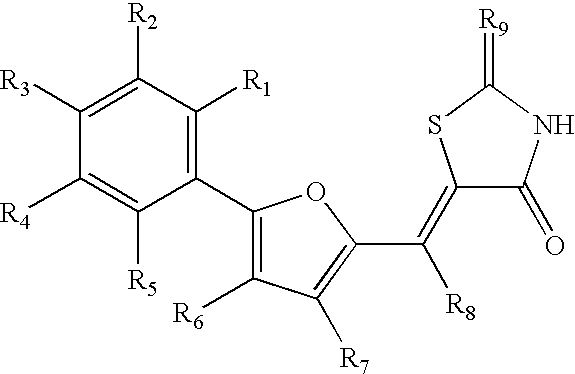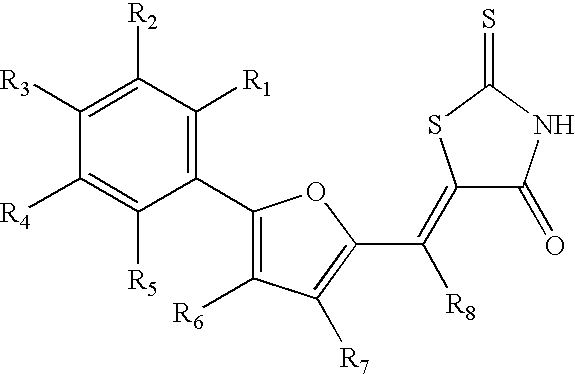Common ligand mimics: thiazolidinediones and rhodanines
- Summary
- Abstract
- Description
- Claims
- Application Information
AI Technical Summary
Problems solved by technology
Method used
Image
Examples
example 1
Preparation of 4-[5-(2,4-dioxo-thiazolidin-5-ylidenemethyl)-furan-2-yl]-be-nzoic Acid (Compound 5a)
[0264] This example describes the synthesis of thiazolidinedione compounds following the scheme shown in FIG. 1. Compound numbers correspond to those in the figure.
[0265] Step a: Formation of 4-(5-formyl-furan-2-yl)-benzoic Acid (compound 3a)
[0266] The compound 4-aminobenzoic acid (compound 1, 60.0 g, 0.438 mol) was suspended in 100 ml of water. The solution was stirred while HCl 12M (225 ml) was added. The resulting suspension was stirred for about 10 minutes and then cooled to 1.degree. C. A solution of NaNO.sub.2 (30.2 g, 0.438 mol) in 200 ml of water was added to the mixture in small portions while maintaining the temperature between 5.degree. C. and 10.degree. C. Addition of the NaNO.sub.2 was accomplished over a time period of approximately 30 minutes. The reaction mixture was stirred at 5.degree. C. for an additional 30 minutes while adding another 300 ml of water. The mixture r...
example 2
Preparation of 3-[5-(2,4-dioxo-thiazolidin-5-ylidenemethyl)-furan-2-yl]-be-nzoic Acid (Compound 5b)
[0275] This example describes the synthesis of thiazolidinedione compounds following the reaction scheme shown in FIG. 1. Compound numbers correspond to those in the figure.
[0276] Step a: Formation of 3-(5-formyl-furan-2-yl)-benzoic Acid (Compound 3b)
[0277] The compound 3-(5-formyl-furan-2-yl)-benzoic acid (compound 3b) was prepared from 3-(5-formyl-furan-2-yl)-benzoic acid (compound 1) following the procedure in step a of Example 1. The compound was prepared in 69% yield and analyzed by NMR with the following results.
[0278] .sup.1H NMR (300 MHz, DMSO-d.sub.6): .delta. 7.42 (d, J=3.43, 1H), 7.63-7.69 (m, 2H), 8.01 (d, J=7.6, 1H), 8.13 (d, J=7.7, 1H), 8.40 (s, 1H), 9.66 (s, 1H); MS: m / z 217 (M+1).
[0279] Step b: Formation of 3-[5-(2,4-dioxo-thiazolidin-5-ylidenemethyl)-f-uran-2-yl]-benzoic Acid (Compound 5b)
[0280] Crude 3-(5-formyl-furan-2-yl)-benzoic acid (compound 3b, 35.0 g, 0.162 mol...
example 3
Preparation of 5-[5-(4-hydroxy-phenyl)-furan-2-ylmethylene]-thiazolidine-2-,4-dione (Compound 5c)
[0283] This example describes the synthesis of thiazolidinedione compounds following the reaction scheme shown in FIG. 1. Compound numbers correspond to those in the figure.
[0284] Step a: Formation of 5-(4-hydroxy-phenyl)-furan-2-carbaldehyde (Compound 3c)
[0285] The compound 5-(4-hydroxy-phenyl)-furan-2-carbaldehyde (compound 3c) was prepared following the procedure in step (a) of Example 1. The compound was prepared in 83% yield and analyzed with the following results.
[0286] .sup.1H NMR (300 MHz, DMSO-d.sub.6): .delta. 6.89 (d, J=8.5, 2H), 7.07 (d, J=3.6, 1H), 7.61 (d, J=3.6, 1H), 7.71 (d, J=8.5, 2H), 9.53 (s, 1H), 10.03 (br. s., 1H); MS m / z 189 (M+1).
[0287] Step b: Formation of 5-[5-(4-hydroxy-phenyl)-furan-2-ylmethylene]-t-hiazolidine-2,4-dione (Compound 5c)
[0288] The compound 5-[5-(4-hydroxy-phenyl)-furan-2-ylmethylene]-thiazolid-ine-2,4-dione (compound 5c) was prepared following the...
PUM
| Property | Measurement | Unit |
|---|---|---|
| Volume | aaaaa | aaaaa |
| Molar density | aaaaa | aaaaa |
| Molar density | aaaaa | aaaaa |
Abstract
Description
Claims
Application Information
 Login to View More
Login to View More - R&D
- Intellectual Property
- Life Sciences
- Materials
- Tech Scout
- Unparalleled Data Quality
- Higher Quality Content
- 60% Fewer Hallucinations
Browse by: Latest US Patents, China's latest patents, Technical Efficacy Thesaurus, Application Domain, Technology Topic, Popular Technical Reports.
© 2025 PatSnap. All rights reserved.Legal|Privacy policy|Modern Slavery Act Transparency Statement|Sitemap|About US| Contact US: help@patsnap.com



